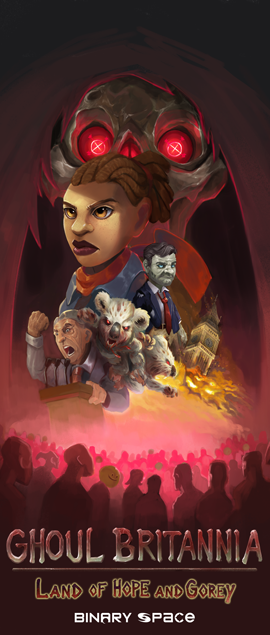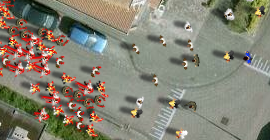Hi everyone!
If you’ve been following us for a while, you might remember some of the major things we’ve done with Class 3 Outbreak and Zombie Outbreak Simulator over the years:
- Way back in November 2009 we released the original Zombie Outbreak Simulator for PC, which has since been played over 1 million times.
- In April 2010 we released the original Class 3 Outbreak for PC, which has since been played over 1.4 million times.
- In April 2011 we released the new Class 3 Outbreak featuring an editor. Since then over 9,500 maps have been created (with over 1,500 of them featured on the home page), and the game has been played over 600,000 times.
- In September 2011 we announced that we were taking a break from the PC version of Class 3 Outbreak for a while, to produce a version of Zombie Outbreak Simulator for iPhone, iPad and iPod touch.
- In April 2012 (last week!) we released Zombie Outbreak Simulator for iPhone, iPad and iPod touch.
So, now that we’ve finally released ZOS for iOS, you may be wondering what we’re going to do next! Jay and I have been discussing the numerous options, and so this post is an update on what we’re currently planning.
Before I go into that, here are a few stats on the release of ZOS on iOS so far:
- Released 11th April 2012.
- 2,835 sales for the first 7 days to date.
- At approx $2 per sale and after Apple’s 30% cut, we’ve made approx $3,900 of profit.
- Currently ranked in the US app store at approx 20 for Simulation Games or Strategy Games (peaked at rank 11 on day 3 in the iPad categories), and ranked approx 190 over all Games (peaked at 127 in the iPad category).

This has been a great response so far, and thanks to everyone who has bought a copy!
Now for another trip through the murky history of ZOS and C3O… :)
Back in April 2011 we announced that we’d been awarded a grant of approx $10,000 from South Australia’s Creative Industries Programme. We owe huge thankyous to Creative SA – this grant has helped us a lot! Sadly it looks like that funding programme has now been discontinued, so we were one of the last few recipients.
The grant covered various expenses related to the PC version of Class 3 Outbreak (such as website hosting, legal costs, music, software, advertising, etc). However the bulk of the grant was to allow us to buy hardware so we could produce a mobile version of the game. So it covered the purchase of Macs, iPhones and iPads for each of Jay and I, which we could use for development and testing.
Then later in April 2011 we launched a crowd funding campaign for Class 3 Outbreak on IndieGoGo. As part of that announcement, we also announced that we’d been awarded a $50,000 grant from the South Australian Film Corporation, for further development of Class 3 Outbreak on PC. We had actually been awarded that grant back in December 2010, but we’d kept it quiet while we negotiated terms with SAFC.
I booked two months of leave without pay from my day job as a software developer, starting mid-June 2011, so that I could work full time on Class 3 Outbreak with the funding from SAFC. Jay and I also decided to pitch in some of our own money to hire two other developers (Luke and David) during that two month period. Luke was going to help us out on the PC version of Class 3 Outbreak, and David was going to produce the iOS version of ZOS, freeing me to also concentrate on the PC version of Class 3 Outbreak (which was what the funding from SAFC covered). We also lined up a graphic designer and writer to help us out.
On top of that we had a great response to our crowd-funding campaign, with over $1300 pledged by 44 people. Huge thankyous to everyone who helped fund us!
Things were going great! And then suddenly… they weren’t.
It’s a long story, but the short version is that the $50k funding from SAFC never came through. We had to let Luke and David go after only about 2 weeks. The money from the crowd-funding campaign disappeared in an instant, with much of it spent on Luke (who developed some great features in his short time with us like building barricades, the show buildings button, and some back-end features to help us out such as with map moderation), as well as other boring things to keep our company going (like accounting). Jay and I had to dip into our own pockets to cover expenses that might have been covered by the SAFC funding, or that we wouldn’t have spent otherwise, to the tune of about $5,000. I went back to my day job sooner than expected, but still had to dip into my mortgage to cover some of the time I’d been without salary.
So then what? We still had the $10,000 grant from Creative SA to develop a version for iOS. David had made a good start on prototyping the iOS version, but there was a lot left to do. Class 3 Outbreak for PC was earning zero income, but had just cost us a whole lot.
That’s why we decided to put Class 3 Outbreak for PC on hold for a while, so we could concentrate on developing Zombie Outbreak Simulator for iOS. As we explained at the time and during development, our hope was that we could earn some income from Zombie Outbreak Simulator on iOS – enough to support future development on both PC and iOS (and maybe even Android).
But wait, there’s more!
Way back around March 2009, when Jay and I first started working together on this project, Jay had his “hey, could we do this on Google Maps?” idea. I’d done some enterprise software development with the Google Maps JavaScript API, so I knew it would be possible. But I also knew that JavaScript (back then) would be slow – we wouldn’t be able to support many zombies at all. Then I discovered that Google had recently released a Flash API for Google Maps. I’d done a little bit of Flash development a long time ago (9 years earlier), and figured we had a chance of doing something. I did some experiments with the Google Maps Flash API and found it worked really well for what we needed. So we then jumped into developing the original ZOS and C3O.
The Flash API for Google Maps has worked really well for us across the three PC versions of ZOS and C3O that we’ve released so far, with over 3 million plays on that API across all versions. However in September 2011, Google announced that they were discontinuing the Flash API. Google’s policy means they will switch off the Flash API 3 years from the announcement, so in September 2014. All our PC versions of ZOS and C3O will suddenly stop working.
So, what can we do? The solution is to rewrite the whole game in JavaScript! Browsers have come a long way in the last 3 years, and it is now feasible to write a version of Class 3 Outbreak which will work with the JavaScript API in modern browsers. But it is of course a lot of work to completely rewrite our game – and we need to get it done by September 2014!
So suddenly the demands on the iOS version of ZOS became much higher – we needed to earn enough to fund a full rewrite of the PC version of the game, and soon.
Then in October 2011 Google announced that they were going to start charging websites for using the Google Maps API. The charges kick in at 25,000 map views per day. We’re currently running at about 4,000 map views per day, so we’re okay for a while. But if we get a bit more popular we’ll have to start paying more to keep C3O running. The kicker though is that Google don’t support charging for over 25,000 map views with the Flash API. Websites which exceed 25,000 map views per day with the Flash API have to switch to the JavaScript API immediately, so even sooner than September 2014 when the Flash API expires.
So by now we were basically hoping for a miracle with ZOS for iOS! :) We needed to be able to afford a rewrite even sooner, and to be able to support higher ongoing running costs too.
Why don’t we charge for the PC version of C3O, so it can support itself? The problem which we’ve had with ZOS and C3O since we began development is that Google only provide their Google Maps API for free if the implementation (ie our game) is free. That’s why C3O on PC has always been free, originally supported by ads (which we removed about a year ago, as they weren’t earning much, but looked ugly). In order for us to start charging for our game on PC, we need to upgrade to a Google Maps Premier license. Last time we checked the minimum cost for this was around $10,000. This is a big investment for us to make – and it would take a lot of sales to recover it. We’d been hoping that iZOS would help fund the purchase of a license too! That would have allowed us to start experimenting with some premium features for C3O on PC, to help it become self-sustaining.
So here’s the conclusion: Although the initial sales for ZOS on iOS have been great, they aren’t enough to fund ongoing development of C3O on PC. In one week we’ve earned more from ZOS on iOS than we’ve earned from C3O on PC in 2.5 years.
So what does this mean? It means that for the near future we’re going to continue concentrating on ZOS on the iPhone / iPad / iPod platform.
We know a lot of our fans of C3O on PC will be disappointed with this. Many of you have been waiting patiently for us to finish ZOS on iOS, so that we could get back to the PC version. Unfortunately it hasn’t worked out as we’d hoped.
We’re still hopeful that we can grow our revenue on iOS, and eventually be able to fund further development on PC. However we have no way of knowing if or when this will happen. Hopefully we can achieve this within the deadlines set by Google!
Since announcing that we were bringing ZOS to iOS, we’ve had many people request an Android version. Although I’d like to do this at some point, for now we don’t have the time or resources to work on porting to Android, for the same reasons as the PC version. The Android platform also has some technical difficulties which may not make it possible, which I wrote about last year.
So what is next for ZOS on iOS? The first update we’re planning is to add some more maps – many of our reviewers have been disappointed to find that only one map was supported. We’ll see what the response is, and then take it from there.
Finally, thankyou to everyone who has been with us along this journey over the last three years. It’s been a lot of fun! :) We’re looking forward to the next chapter of releasing future updates on iOS.
Saxon


